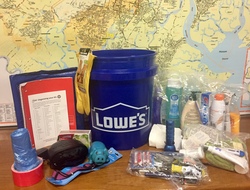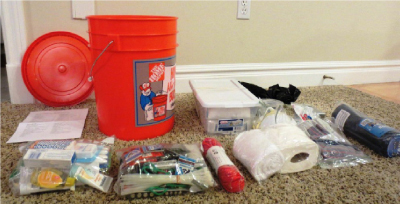Community
Building your five gallon emergency kit can save you money and help you survive a disaster! It's easy, but it can also be fun and educational if you include the whole family.

This kit can be used during a hurricane or other severe weather events by adding a few items.
Surviving a small or large scale disaster depends a lot on how prepared you are. You play a role in your safety and your family's safety. An easy and very organized way to be prepared is to build an emergency kit. If you build your own it gives you a certain intimacy with your kit - you know exactly what's in it and you know how to use it. Putting together your own kit means you can custom tailor what's important to you, your family and your community. For example, if a family member has allergies, some that can kill very quickly, an EpiPen may be a critically important supply.
Just remember to put a date on your kit so you will know when you assembled it and can check expiration dates for certain items. A good emergency kit can easily last five years or more, but not everything inside will be good for that long and may need to be periodically replaced. Again, the EpiPen example -they only last about 20 months from the day they are made. Replacing an expired EpiPen could be a life or death matter!
A kit should always be tailored to what's likely to happen in your area and your family's needs. Every item should be listed in detail on a printed contents document. On the back, list important phone numbers such as relatives, insurance companies, police, fire, etc. Remember, store water and non-perishable food for you and your pets separately.
ORGANIZING YOUR KIT

Hygiene Supplies
- bar soap
- tissues
- floss
- baby shampoo
- hand lotion
- sunscreen
- toothpaste
- toothbrushes
- feminine hygiene pads
- comb
- toilet paper
- wash cloths
First Aid Supplies
- basic first-aid guide
- moist towelettes
- antiseptic towelettes
- latex gloves
- acetaminophen (Tylenol)
- ibuprofen (Advil)
- aspirin
- diphenhydramine (Benadryl)
- loperamide (ImodiumA-D)
- burn cream
- sting relief towelettes
- hydrocortisone cream
- triple antibiotic ointment (Neosporin)
- cough drops
- earplugs
- instant ice pack
- tweezers
- nail clippers
- scissors
- digital thermometer
- cotton balls
- waterproof adhesive
- gauze rolls
- gauze pads
- moleskin
- band-aids
- butterfly bandages
- ace bandage
- triangular bandage
Pet Supplies
- collar
- leash
- medical and vaccination
- records
- extra food and water
General Supplies
- glow sticks (12 hrs)
- flashlight
- liquid candle
- matches
- mylar blankets
- hand warmers
- AM/FM radio
- whistle and lanyard
- sewing kit
- blank notebook
- pencils
- batteries (for flashlight and radio)
- zip ties
- P-38 can opener
- trash bags
- N95 dust masks
- duct tape
- small tarp
- paracord
- safety goggles
- work gloves
Food and Water
- It may be beneficial to store food with your emergency kit so that if you need to evacuate, or you need to shelter in place, you will have food to sustain you and your family.
- If you do not regularly eat canned chicken or freeze dried ice cream, don't put it in your emergency kit. Try to include non-perishable foods that you and your family eat on a regular basis. Trying to introduce your children to new foods in the middle of an already stressful event may be difficult.
WHERE TO KEEP YOUR KIT
When determining the best place to store your emergency kit, keep in mind that you will need your kit handy during an emergency. If there were or tornado warning in your area and you needed to seek shelter immediately, you would want your emergency kit nearby. Therefore, storing your kit in a closet or interior room may be ideal! This would also allow the materials inside the kit to remain in a temperature controlled environment.
Regardless of where you store your kit, just ensure that you and your family know exactly where it is stored and what's inside of it so that anyone can access it during an emergency.
For a printable version, click the link below:
